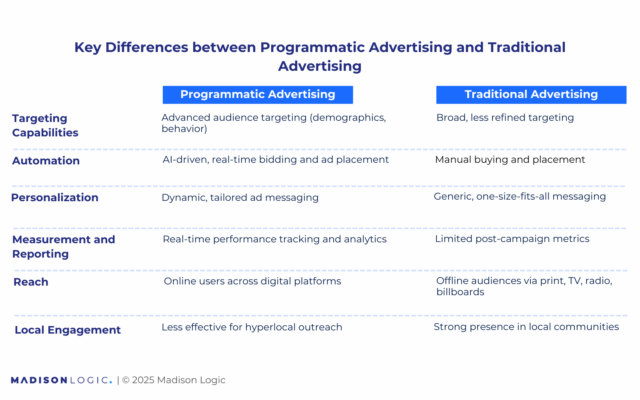
Unlock Global ABM at Scale — Madison Logic strengthens ABM reach with Connected TV and Audio expansion globally. Learn More
Unlock Global ABM at Scale — Madison Logic strengthens ABM reach with Connected TV and Audio expansion globally. Learn More

Account-based marketing (ABM) has always been about precision—getting the right message to the right person at the right time. But in today’s world of competing messages and longer buying cycles, precision alone isn’t enough. To stay competitive, marketers need speed, automation, and scalability. That’s where programmatic advertising comes in.
Traditionally, ABM campaigns required extensive manual effort, from selecting target accounts to personalizing messaging and running campaigns across multiple channels. While this resource-intensive process often limits ABM’s full potential, the evolutions in marketing automation platforms and software provide ample opportunities to make your ABM campaigns repeatable and scalable, which helps ensure you’re running your best ABM campaigns at all times.
Expanding into programmatic ads offers a data-driven, automated approach that accelerates and refines your ABM strategy by delivering highly personalized, real-time messaging at scale. But how exactly do programmatic ads fit into ABM? What types of data power this strategy, and how do you know if it’s the right fit for your company? In this guide, we’ll break down how programmatic advertising enhances ABM efforts, what you need to execute it effectively, and how to determine if your company is ready for programmatic ABM in your campaign strategy.
Programmatic advertising automates the buying and placement of digital ads, using real-time bidding and data-driven decision-making to reach targeted buyers. Unlike traditional ad buying, which relies on manual negotiations and predefined placements, programmatic technology leverages machine learning algorithms and artificial intelligence (AI) to optimize ad delivery across multiple channels. It’s like an intelligent assistant that uses a computer system to help you target the accounts that matter when they’re online.

While programmatic advertising initially gained traction in B2C marketing, its role in B2B has expanded significantly in recent years, especially within ABM strategies. Advancements in intent data, IP-based targeting, and account-level personalization have transformed programmatic into a powerful tool for engaging high-value accounts.
Programmatic advertising is now a core component of modern ABM strategies, enabling B2B marketers to deliver more relevant, efficient, and scalable engagement opportunities across the buyer journey.
B2B buying cycles are long, complex, and involve multiple decision-makers on a buying committee. Each member has their own pain points and challenges that they will base their purchase decision on. Mainly, each stakeholder is asking a variation of, “Will this help me do my job better?”
Each stakeholder is being targeted by your competitors, so it’s essential to consistently show up where they are throughout the buyer journey with relevant content across the channels where they spend their time throughout the day.
According to a study between Bain & Co. and Google, 90% of buyers choose vendors from their Day 1 list. Programmatic ads help build brand awareness and familiarity over time, increasing the chances that your brand is brought into the conversation when the buying group is ready to decide. The more stakeholders you influence—and the earlier you can begin to influence them—the easier it becomes to end up on that Day 1 list, build consensus, and win the deal.
Here’s how leading B2B teams are putting programmatic advertisements to work within their ABM strategy:
Programmatic advertising enhances ABM by delivering targeted, data-driven engagement at scale, making it easier for B2B marketers to engage buyers wherever they are.
When integrated into an ABM strategy, programmatic advertisements deliver a range of benefits that improve both execution and outcomes across the buyer journey:
Effective programmatic ad targeting in B2B marketing relies on multiple data sources to ensure ads reach the right accounts, at the right time, with the right message. By leveraging different types of data, marketers can refine audience and lead segmentation, optimize ad spend, and personalize campaigns based on real-time insights. Below are key data types that power programmatic ad targeting in ABM.
First-party data includes data collected directly from a company’s own interactions with prospects and customers, such as website visits, surveys, and email engagement. First-party data enables precise retargeting, helping marketers serve ads to known contacts based on their behavior and interests.
Marketers can build highly tailored audiences by combining multiple data sources, such as first-party data, intent signals, and firmographics. These custom segments help refine targeting for programmatic campaigns, ensuring ads reach the most relevant accounts and decision-makers.
Firmographic data, such as company size, industry, and revenue, helps you target accounts that match your ideal customer profiles (ICP). Programmatic platforms use this data to prioritize high-value accounts and exclude those that don’t fit.
Understanding the technology stack a company uses allows you to target businesses based on their software, application infrastructure, or IT investments. Programmatic ads can then highlight relevant solutions that integrate with or enhance their existing tech environment.
Intent data reveals which accounts are actively researching specific topics, indicating potential purchase interest. By using programmatic advertising, marketers can serve relevant ads to accounts showing buying intent, which helps to accelerate pipeline progression.
For ABM campaigns, marketers can upload target account lists into programmatic platforms to ensure ads are only shown to high-priority target accounts. This approach maximizes budget efficiency by focusing on pre-identified companies.
Third-party data from external sources like data providers, B2B research, and install bases extends reach beyond first-party audiences. It’s useful for prospecting new accounts, enriching targeting criteria, and scaling ABM campaigns to engage previously unknown but relevant buyers.
Programmatic advertising offers powerful benefits for B2B marketers, but it’s not a one-size-fits-all solution. Before investing, it’s important to assess whether your company has the right foundation to maximize its impact. The following questions help determine if programmatic advertisements are a good fit for your marketing efforts, covering areas like audience targeting, data and tech readiness, team alignment, and measurement capabilities.
To determine if programmatic ABM is a smart investment, B2B marketers must assess whether their target audience is well-defined, digitally engaged, and large enough to justify automated outreach. The following questions help evaluate audience clarity, scalability, and channel fit—key factors in making programmatic efforts effective and efficient.
Many marketers worry about wasting budget on too broad or misaligned audiences or launching campaigns their ideal buyers will never see. These questions help surface those concerns early—whether you’re in an emerging company looking to grow pipeline quickly or an enterprise focused on expanding wallet share. Collaborating with sales, analyzing CRM and intent data, and reviewing past campaign performance will lead to the answers you need to decide if now is the time for programmatic ABM. Consider industry nuances, too: niche verticals or long sales cycles may require a more tailored approach than broad tech or SaaS markets.
Programmatic ABM depends on clean, actionable data and the right tech stack to target, engage, and convert accounts efficiently. These questions help assess whether your systems and data sources can support a data-driven campaign.
Many marketers struggle with disconnected ABM tools or incomplete data, which leads to missed targeting opportunities. It’s critical to evaluate whether your first-party data is accessible and accurate. Enhancing your intent data with third-party data providers and integrating systems like demand-side platforms (DSPs), customer data platforms (CDPs), and CRMs ensures campaigns are precise and scalable. Tech maturity often varies by company size, so smaller or earlier-stage organizations may need to build partnerships or make gradual investments to become programmatic-ready.
Even the best strategy will stall without the right investment and people in place. These questions help you evaluate if your organization has the financial and operational capacity to support programmatic ABM.
Programmatic ABM requires more than ad dollars—it demands ongoing campaign optimization, testing, and strategic oversight. For marketers juggling limited budgets, it’s important to weigh programmatic costs against other ABM priorities. If internal bandwidth is tight, partnering with an agency or specialist can help bridge execution gaps. This is especially relevant for mid-sized and growing companies trying to scale ABM without overloading lean teams.
Success with programmatic ABM hinges on tight coordination between sales and marketing. These questions evaluate whether both teams are aligned on targets, messaging, and measurement.
Without clear alignment, programmatic ads can create noise instead of moving accounts through the funnel. Ensuring both teams agree on the target account list, campaign goals, and success metrics is foundational to any campaign’s success. Integrating engagement signals from ads into sales workflows is equally important. In organizations with fragmented sales and marketing processes—common in larger or fast-scaling companies—aligning upfront will save time and budget downstream.
Programmatic ABM is built for efficiency at scale but only works when paired with clear goals and the ability to measure impact. These questions help determine if your team is set up to grow and evaluate campaigns effectively.
Manual ABM tactics can’t keep up when targeting dozens or hundreds of accounts. Programmatic offers a scalable alternative—but only if it’s part of a broader engagement and measurement strategy. Marketers should consider whether their campaigns can effectively reach entire buying groups, not just individuals, and if there’s a measurement plan in place to connect ad engagement to pipeline through ABM KPIs.
Programmatic is a key component in ABM, but without a clear, holistic view of your data to inform not only your target account list, but your content strategy and how your campaign is performing, you can’t continue to build relationships that last. The ML Platform integrates with your CRM and marketing automation platform so you can share data to inform your entire programmatic campaign strategy. You have the intelligence and the power to create programmatic ABM campaigns that convert across the entire buying journey, not just at the beginning.
With buying committees expanding upward of 14-23 stakeholders, you need to be where your buyers are at all times—especially in emerging marketing channels. Did you know that 83% of business decision-makers listen to podcasts every week? And that it’s expected that 87% of U.S. households are watching CTV every day? CTV and audio streaming services are quickly emerging into two of the most powerful channels you should use to speak to your B2B buyers. And with audio ads showing a 60% higher recall rate and interactive ads from CTV reaching a 34% recall rate, these two channels help you deliver a message that lasts. Learn more about ABM Audio Advertising and ABM CTV, and how these emerging B2B channels influence your ABM strategy to truly surround the buying committee wherever they are.